Expect a royal reception as Scotland’s grandest properties open their doors once more and look forward to welcoming you back
MORE FROM SCOTLAND MAGAZINE
As the world locked down and we were forced to spend weeks or months at a time confined to our own homes, many of us no doubt fantasised about how much better it would be to quarantine in a Bridgerton-scale house, with a scandalously big estate all to ourselves.
The truth is, while some of Scotland’s palatial properties remain family homes, many more have been turned into heritage houses and great museums to meet the astronomical running costs, including heating, and carrying out fragile restoration projects.
Luckily, organisations such as Historic Environment Scotland and the National Trust for Scotland are there to offer a buffer to country piles that might otherwise fall to ruin or be closed off to the public.
Stately homes and castles are huge attractions to Scotland’s visitors, offering windows into the past. Without visitors, they become little more than mausoleums to past lives, gathering dust as the shutters go down and the curtains are closed. Throughout the pandemic, though locals have been able to make use of their incredible grounds for exercise, for most of the past year-and-a-half their interiors have been out of bounds. Thankfully, they are opening once again.
The National Trust for Scotland’s Chief Executive Philip Long OBE sums up the relief and excitement among custodians of these historic houses as they prepare to reopen: “Everyone at the Trust is looking forward to welcoming our visitors back to the beautiful places we protect,” he says. “Across Scotland, our teams are hard at work preparing for reopening and giving everyone a warm, and of course, safe welcome.”
Whether you can make it this year, or are planning to visit next year, here are some of the finest castles and country houses across Scotland that you should factor into your next trip.
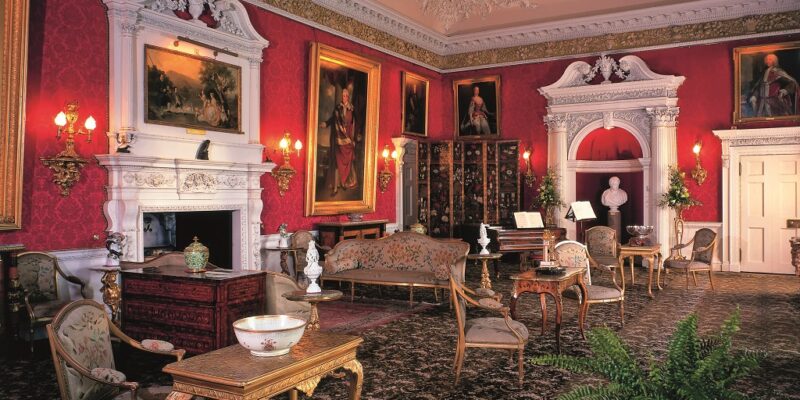
Though the annual Atholl Highlanders Weekend won’t take place in 2021 (it is scheduled for 28-29 May 2022), there are other reasons to visit the ancestral seat of the Duke of Atholl, the hereditary Chief of Clan Murray, before then.
The castle is currently displaying a stunning piece of Scottish history for the first time ever – a letter from Bonnie Prince Charlie to his loyal supporter and military strategist Lord George Murray, brother to the 2nd Duke of Atholl, James Murray, in which he calls Lord George an “idiot” for suggesting a war council.
Keren Guthrie, the castle archivist, says of Charlie’s letter: “So much is romanticised about Bonnie Prince Charles, but this letter catches him in a moment of utter frustration – and perhaps misguided in the belief in his own abilities. George was very loyal to the Jacobite cause and his brother William was a close confidant of the Young Pretender, so the tone is all the more remarkable.”
The letter forms part of a new long-term exhibition at the castle, A Family Divided – The Atholls and the Jacobite Risings, which includes many letters written to and from the Murray family during the 18th century, demonstrating just how conflicted they were over the Jacobites.
In another letter, Lord George Murray writes to his brother William saying that he is prepared to storm the castle and demolish the family home in the name of the cause. William, who has already been disinherited for his alliance to the Jacobites, replies saying he has no qualms about destroying family artworks in the face of public service.
As well as personal letters, the exhibition, which will run for the next few years, includes: a pardon obtained by the 1st Duke for his son George after the first Jacobite Rebellion of 1715; a compass said to have been used by Bonnie Prince Charlie; and a canon ball kept after the siege in 1746. blair-castle.co.uk
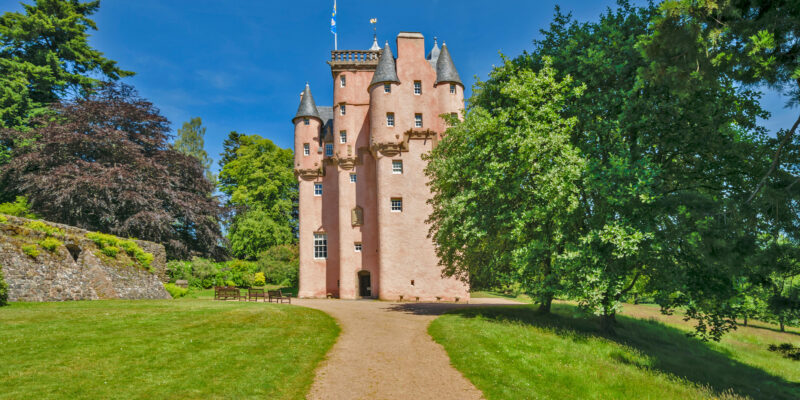
Visitors to the pretty-in-pink castle of Craigievar, the supposed inspiration for Walt Disney’s Cinderella castle, can now walk a path that follows the castle’s 16th-century footprint for a deeper sense of what life here may have been like hundreds of years ago.
With building begun in 1576 and completed c.1626, Craigievar is one of the best-preserved examples of a Scottish Baronial tower house castle, and its exterior remains virtually unchanged. The former seat of Clan Sempill, and the Forbes’ family home for 350 years, the castle was donated to the National Trust for Scotland (NTS) in the 1960s.
However, a key part of the castle’s design – what is known as a Barmkin (an enclosure that would have held a courtyard) – has long been forgotten. Now, using 3D technology, archaeological studies and old plans and paintings, the NTS has been able to reveal what the lost walls and the fortifications of the castle would have looked like and visitors can now walk the defensive lines.
Dr Daniel Rhodes, NTS archaeologist, says: “To be able to take our archaeological knowledge and recreate the past for our visitors to enjoy is a fantastic opportunity. It must have been a bustling courtyard often full of livestock and people. A real comparison to today’s fairytale beauty.” nts.org.uk/visit/places/craigievar
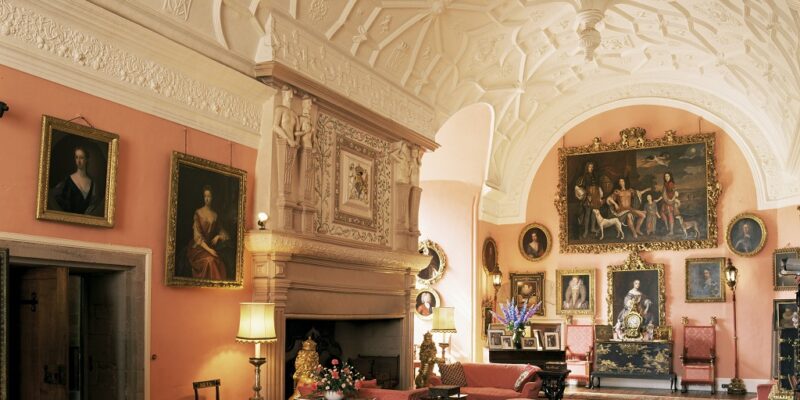
Though it is the family home of the Earls of Strathmore and Kinghorne, Glamis Castle has long been associated with strong female figures, including the Queen Mother, who grew up here, and Princess Margaret, who was born here.
In 2021, the castle is extending its Women of Glamis exhibition – which tells the stories of some of the remarkable women who have lived here, from the late 14th century to the present day – until 31 October.
Stories include those of the nursemaid, Annie Jackson, who saved the life of the 13th Earl’s grandson Hubert, when the ship SS Sidon was wrecked off the Bay of Biscay in 1885. It will also delve into the pasts of two of the Queen Mother’s family members – her cousin, Lilian Bowes Lyon, the author/poet who sponsored two Jewish boys during the Second World War, and her aunt, Lady Mildred Bowes Lyon, a promising opera composer.
New exhibits for this year include a magnificent reproduction of the 18th-century bridal gown worn by Mary Eleanor Bowes, the richest heiress in Great Britain at the time. Mary Eleanor was reputedly buried in her silver and white Rococco-style wedding dress, which was encrusted with diamonds, in Poet’s Corner, Westminster Abbey in 1800. Alongside this dress is an original mid-18th-century dress believed to have been worn by Lady Margaret Ogilvy, a leading Jacobite, when she was presented at court to Bonnie Prince Charlie at the Palace of Holyroodhouse in 1745, and a replica of the Queen Mother’s engagement dress.
Angus is often overlooked by visitors to Scotland but the Insider’s Guide to Angus – 100 Unmissable Experiences has lots of ideas for further exploration in the region. glamis-castle.co.uk
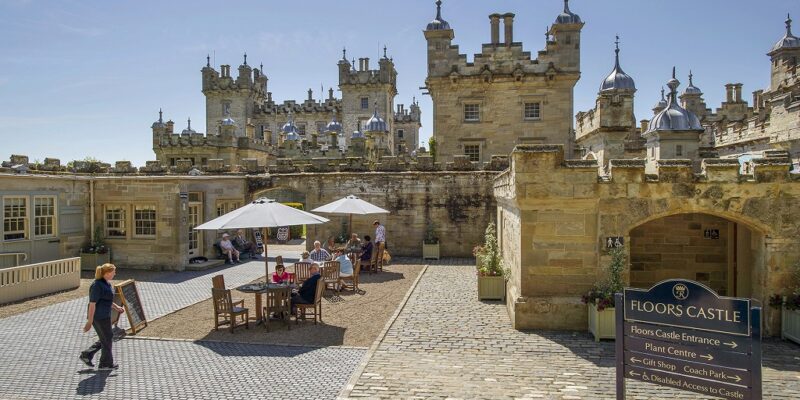
This year is the 300th anniversary of Scotland’s largest inhabited castle, Floors Castle, which was originally built as a much smaller Georgian house.
In 1721, John Ker, 1st Duke of Roxburghe, commissioned leading Scottish architect William Adam to significantly remodel his home of Floors Castle into a spectacular property fit for a ducal seat.
This year, Floors will celebrate this tricentenary with an exhibition that will also run through the 2022 season, on the 1st Duke of Roxburghe. The Duke’s story is told through letters, written mainly from him to his mother, which offer unique insight into the times he lived in.
The Duke’s rise to prominence coincided with the fall of the Catholic monarchy, the rise of Jacobitism and the Glorious Revolution, as well as the War of the Spanish Succession, and the creation of modern Britain through the Union of 1707.
Floors is an exceptionally grand palace, with two symmetrical wings, and it is topped with battlements, turrets and finials – additions made in the 19th century by the esteemed architect William Playfair. floorscastle.com
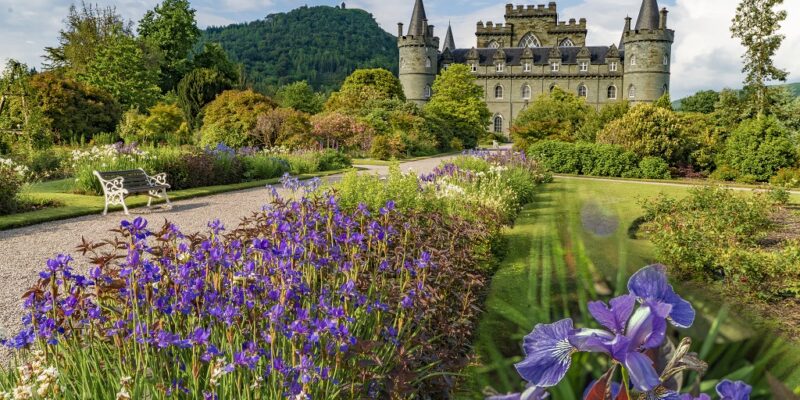
One of Scotland’s most iconic castles, Inveraray is due to open any day now. The home of the Dukes of Argyll and the seat of Clan Campbell, Inveraray is still a family home and is the foremost place to learn about the part the Campbells played in the history of Scotland. For a small fee, you can view the Argyll Papers, the archive collection of the earls and dukes and their families, an invaluable resource, particularly if you are researching Campbell family history, but you must book in advance.
Campbell connections or not, Inveraray is one of the most impressive of all of Scotland’s buildings. Sitting on the shores of Loch Fyne, its bold exterior with its conical turrets earned it a starring role as ‘Duneagle’ in Downton Abbey’s 2012 Christmas special.
Its dark-grey colour is too austere for some, but don’t let that fool you. Inside are some of the most resplendent neoclassical rooms of any stately home, including the Parisian-style Tapestry Drawing Room, which still has its original Beauvais tapestries, designed especially for this room, in situ.
This year’s main exhibition is on Princess Louise – the Duchess of Argyll, and daughter of Queen Victoria – and her husband the Marquis of Lorne, and entry is included with tickets to the castle. inveraray-castle.com
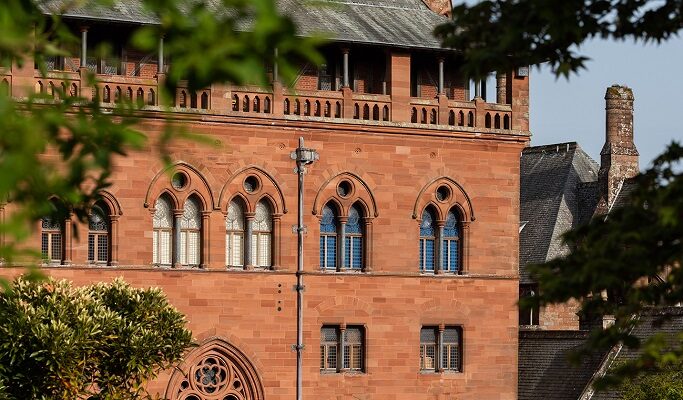
Originally built in 1719, when it was rebuilt following a devastating fire in 1877, Mount Stuart was at the forefront of Victorian home innovation.
Though the Georgian wings and much of the contents survived, inside it evolved into a contemporary Victorian property, with numerous mod-cons for the time, including what is thought to be the first domestic heated swimming pool, an early telephone system and a passenger lift. It was also the first house in Scotland to be wired for electricity.
Today, Mount Stuart continues to innovate and this year it celebrates 20 years of presenting visual arts here, with an exhibition by Ilana Halperin inspired by the geology of the Isle of Bute, which will run until 15 August 2021.
The title, There is a Volcano Behind My House, references the extinct volcano behind the artist’s Isle of Bute home, and the exhibition includes watercolours inspired by geological features on the isle, such as the Highland Boundary Fault Line, which bisects the island, and two large-scale woven textile works produced in partnership with Bute Fabrics.
If you can’t make it here before the end of the exhibition, don’t worry. Mount Stuart has a rolling programme of shows, and the architectural details of the house itself, which includes mosaic detailing inspired by St Vladimir Cathedral in Kiev and its beautiful marble chapel, will more than hold your interest. mountstuart.com
MORE FROM SCOTLAND MAGAZINE

SCOTLAND MAGAZINE
Published six times a year, every issue of Scotland showcases its stunning landscapes and natural beauty, and delves deep into Scottish history. From mysterious clans and famous Scots (both past and present), to the hidden histories of the country’s greatest castles and houses, Scotland‘s pages brim with the soul and secrets of the country.
Scotland magazine captures the spirit of this wild and wonderful nation, explores its history and heritage and recommends great places to visit, so you feel at home here, wherever you are in the world.